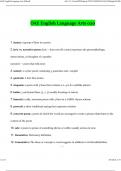OAE English Language Arts 020.pdf file:///C:/Users/HP/Desktop/TYPA%20NEW/OAE%20English%20La
OAE English Language Arts 020
1. stanza: A group of lines in a poem
2. lyric vs. narrative poem: lyric -- does not tell a story/expresses the personalfeelings,
observations, or thoughts of a speaker
narrative -- poem that tells story
3. sonnet: a 14 line poem containing 3 quatrains and 1 couplet
4. quatrain: A four line stanza
5. cinquain: a poem with 5 lines that contains a 2-4-6-8-2 syllable pattern
6. haiku: 3 unrhymed lines (5, 7, 5) usually focusing on nature
7. limerick: a silly, nonsense poem with 5 lines in a AABBA rhyme scheme
8. proverb: a short traditional saying that expresses wisdom
9. concrete poem: a poem in which the words are arranged to create a picture thatrelates to the
content of the poem
10. ode: A poem in praise of something divine or noble; usually serious in tone
11. Denotative: Dictionary definition
12. Connotative: The ideas or concepts a word suggests in addition to its literaldefinition.
1 of 31 8/8/2024, 3:19
,OAE English Language Arts 020.pdf file:///C:/Users/HP/Desktop/TYPA%20NEW/OAE%20English%20La
13. Reading Comprehension Strategies: Understanding what you have read bymaking
connections, questioning, visualizing, inferring, synthesizing and metacog-nition.
14. Literal Comprehension: The lowest level of understanding. It involves readingthe lines and
understanding exactly what is on the page. Students can repeat or paraphrase what they have
read.
15. Inferential Comprehension: Understanding of information that isn't explicitlygiven, but
rather implied in a written passage. (make predictions)
16. Evaluative Comprehension: Ability to use critical thinking skills, logical analy-sis, and
aesthetic considerations to evaluate a text.
17. Appreciative Comprehension: Considering the author's purpose for writing the text. You
may not "like" classical music, but can you appreciate the skill, talent, andyears of training of the
musicians or composer?
18. Stylistic Text Features: Figurative Language to Text Style
19. Informational Text: Nonfiction written primarily to convey factual information.
Informational texts comprise the majority of printed material adults read (e.g., textbooks,
newspapers, reports, directions, brochures, technical manuals).
20. Persuasive Text: Writing to present an argument or point of view; editorials,
propaganda, advertisement.
2 of 31 8/8/2024, 3:19
,OAE English Language Arts 020.pdf file:///C:/Users/HP/Desktop/TYPA%20NEW/OAE%20English%20La
21. Rhetorical Devices: Rhetorical devices are common, such as saying languageis a living
beast: that's a metaphor — one of the most common rhetorical devices. Another is alliteration,
like saying "bees behave badly in Boston." Rhetorical devices
3 of 31 8/8/2024, 3:19
,OAE English Language Arts 020.pdf file:///C:/Users/HP/Desktop/TYPA%20NEW/OAE%20English%20La
go beyond the meaning of words to create effects that are creative and imaginative,adding
literary quality to writing.
22. Drama Characteristics: Highly emotional, usually focuses on humans andinvolves a
"crisis of feeling" - a painful or harmful experience.
23. Poetry Characteristics: Figurative language, meter, sound, imagery, format.
24. Meter: Beat or Rhythm in Poetry
25. Iamb: Unstressed, Stressed
26. Trochee: Stressed, Unstressed
27. Anapest: Unstressed, Unstressed, Stressed
28. Dactyl: Stressed, Unstressed, Unstressed
29. Phonemes: In a language or dialect, this is the smallest segmental unit of soundemployed to
form meaningful contrasts between utterances.
30. Allophones: The subtle variations of phonemes that occur as a result of con-textual
influences on how phonemes are produced in different words
31. Rhetoric: The art or study of persuasion through speaking or writing; languagethat is
elaborate or pretentious but actually empty, meaning little
32. Structural Elements: Exposition, Climax, Meter, Stanzas
4 of 31 8/8/2024, 3:19




